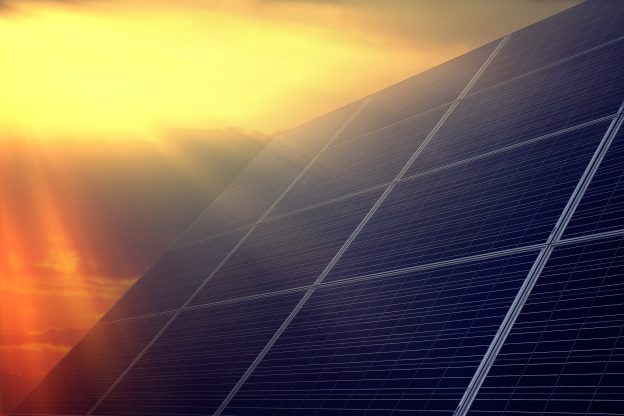Strong Demand Growth Throughout the Year, Good Inventory Digestion
Module exports increased by more than 30% year-on-year, indicating strong overseas demand. According to Gaixi Consulting, the cumulative export of module s in January and February 2024 was 36.95 GW, a year-on-year increase of 33.8% and a month-on-month increase of 20.8%. The year-on-year increase of more than 30% confirms the judgment of high global demand this year, and the month-on-month increase of more than 20% indicates that the destocking of module s is good, and the apparent demand of module s and the terminal installation data are gradually synchronized.
The decline in average module price dragged down the export value. The cumulative export value of module s in January and February was 5.339 billion US dollars, a year-on-year decrease of 23.4% and a month-on-month increase of 19.7%. The main reason is that the average export price dropped to 0.144 yuan/W.
The export data of inverters is relatively flat due to inventory reasons. The export value of inverters in January and February 2024 was 1.016 billion US dollars, a month-on-month decrease of 12.01% and a year-on-year decrease of 47.89%. The main reason for the year-on-year decrease is the high base last year. Among them, the export value of inverters in January and February was 567 million and 449 million US dollars respectively, a month-on-month decrease of 4.73% and 20.73%. February was mainly affected by the Spring Festival holiday and the number of days.
In addition, the export volume of batteries in January and February 2024 reached 12.15 GW, a year-on-year increase of 89.26%, and the export value was 510 million US dollars, a year-on-year decrease of 35.4%. In terms of types, battery exports are mainly concentrated in India (5.56 GW), Turkey (2.78 GW), Cambodia (1.62 GW), South Korea (411 MW), and Indonesia (299 MW).


 New monthly high in scale, demand blossoms in multiple places
New monthly high in scale, demand blossoms in multiple places
This year, we have consistently emphasized that the non-European and American overseas markets are expected to exceed expectations. In January and February 2024, the export of module s to these markets reached 25.41GW, an 83.2% increase year-on-year and a 10.7% increase month-on-month. The scale of exports in January alone, at 13.90GW, set a new historical record. The growth rate of exports to India was affected by the base number and policy factors. Excluding India, the export of module s to non-European and American overseas markets in January and February was 20.08GW, a 55.1% increase year-on-year and a 12.1% increase month-on-month, maintaining a relatively rapid growth rate. The non-European and American overseas markets are relatively less disturbed by inventory and consumption issues. The price drop of module s is gradually stimulating demand, and we continue to be optimistic about the explosive demand in these markets in 2024, which will provide support for global module demand.

India: High Module Export Volumes Continue, Installation Growth Recovers
India's high module export volumes continue, and there's also a surge in the scale of solar cell exports. Since India implemented BCD tariffs, our country has virtually ceased exporting modules to India. However, with the domestic module prices falling, the current price level in India remains high at $0.22/W. Even considering the tariffs, module manufacturers still choose to ship to India. In January and February 2024, the module export volume to India was 5.33GW, a 477.9% increase year-on-year and a 5.8% increase month-on-month. Additionally, we observe that photovoltaic exports to India are not limited to modules alone. In January and February 2024, exports of photovoltaic cells to India amounted to 5.56GW, a 308% increase year-on-year, showing explosive growth as well; low module prices offset the tariffs, and installations are expected to resume growth. Due to supply chain shortages in 2023, India's photovoltaic new installations were only 10.16GW, a 28.2% decrease year-on-year. However, as exports to India gradually recovered in the second half of 2023, India's installations are expected to grow again in 2024. According to the data from January and February, India's photovoltaic new installations were 2.26GW, a 109.36% increase year-on-year. The export value of inverters in January and February was $0.55 million, a 34.92% increase year-on-year, which also serves as evidence of this trend.

Brazil: Centralized Volume Increase May Offset the Impact of Additional Tariffs
The Brazilian market has seen an increase in demand stimulated by interest rate cuts combined with the reinstatement of import tariffs. In January and February 2024, Brazil's module exports were 4.19GW, a 39.7% increase year-on-year but a 1.0% decrease month-on-month; inverter exports were $111 million, a 7.4% decrease year-on-year but an 11.9% increase month-on-month, with February inverter exports alone at $53 million, a 14.8% increase year-on-year. There was an expectation that the reinstatement of photovoltaic module import tariffs in 2024 would lead to a decline in module export volumes, but the data from January and February shows that the volume has remained strong. This is mainly due to robust demand for centralized power station installations amidst expectations of interest rate cuts and falling module prices. In 2023, Brazil's photovoltaic new installations reached 13.5GW, a 27.8% increase year-on-year, with distributed and centralized installations adding 9.4GW and 4.1GW respectively, up 20.56% and 48.36% year-on-year, indicating a significant surge in centralized installations.。

The Middle East: Off-grid scenarios and module price reductions lead to a widespread surge in photovoltaics
The Middle Eastern market has shown a strong desire for energy transformation, with a significant demand explosion driven by the reduction in module prices. In 2023, the export of modules to four Middle Eastern countries (Israel, UAE, Oman, and Saudi Arabia) reached 11.5GW, a year-on-year increase of 94.1%. Of this, exports to Saudi Arabia accounted for 8.2GW, up 645.7% compared to the previous year. In January and February 2024, the export of modules to these four countries was 2.57GW, a year-on-year increase of 114.4%, with a virtually flat month-on-month performance. The Middle East benefits from excellent solar conditions and a strong willingness to transition energy sources, leading to a noticeable demand surge due to falling module prices. Looking at the structure, Saudi Arabia's module exports in January and February 2024 were 1.58GW, up 245.8% year-on-year but down 26.3% month-on-month; the UAE reached 592MW, up 15.5% year-on-year and 102.4% month-on-month; Oman at 241MW, up 98.9% year-on-year and 215.6% month-on-month; Israel at 157MW, up 44.6% year-on-year and 168.0% month-on-month. Oman, Israel, and the UAE all showed exceptional growth both year-on-year and month-on-month, while Saudi Arabia's high year-on-year growth was offset by a decrease month-on-month, possibly related to the off-grid demand cycle. Saudi Arabia plans to achieve a hydrogen production of 400 tons by 2030, with photovoltaic hydrogen production as one of the main methods, indicating that the high base in the second half of 2023 may be due to off-grid photovoltaic hydrogen production demand.
Pakistan: Price reductions and policy resonance lead to a significant increase in export growth
The combination of reduced module prices and policy support has led to a rapid increase in Pakistan's module export volume. In 2021, 2022, and 2023, Pakistan's module export volumes were 783MW, 3.16GW, and 5.77GW, respectively, showing year-on-year increases of 6.2%, 303.0%, and 82.8%, with a rapid expansion in scale. In January and February 2024, the module export volume was 2.8GW, a year-on-year increase of 326% and a month-on-month increase of 96.02%. The rapid growth in export volume is mainly due to the improved economic viability of projects following the reduction in module prices, with policy also playing a significant role. The Alternative Energy Development Board of Pakistan aims to rapidly achieve 9GW of solar power generation nationwide, with projects expected to be completed at the beginning of 2024. The 9GW solar plan consists of three parts: large-scale ground-mounted solar projects with an installed capacity of 6GW through the IPP (Independent Power Producer) scheme; medium-sized solar projects under 4MW with an installed capacity of 2GW through the IPP scheme; and rooftop photovoltaic installations on federal public buildings with an installed capacity of 1GW through the EPC (Engineering Procurement Construction) scheme.

Other Markets: Steady Growth
The remaining markets have generally shown a trend of steady growth. Japan's module exports for January and February amounted to 1.14GW, a year-on-year increase of 14.81%; Australia reached 826MW, up by 21.1% compared to the same period last year; Chile exported 391MW, marking a 24.9% increase year-on-year.
Europe: Significant Warming with Strong Inventory Depletion, Anticipated Growth
European module exports saw a significant month-on-month increase, with the scale further expanding in February, indicating a clear recovery in demand. The exports from eleven European countries in January and February totaled 11.44GW, a year-on-year decrease of 16.6% but a month-on-month increase of 52.3%. Specifically, exports in January and February were 5.28GW and 6.16GW respectively, showing a year-on-year decrease of 25.2% and 7.4%, while improving month-on-month by 30.11% and 16.7%. The year-on-year decline is mainly due to a high base effect, while the month-on-month improvement indicates strong European demand. Against the backdrop of robust end-user demand in countries like Germany, this reflects further depletion of inventory. Notably, in February, despite the impact of the Chinese New Year, European module exports reached 6.16GW, further increasing month-on-month and narrowing the year-on-year decline, indicating robust European demand.
Module exports from five European countries increased both year-on-year and month-on-month, with the Netherlands representing the upward trend in most regions. Looking at different regions, Portugal, Greece, France, Belgium, and Slovenia all experienced growth in both year-on-year and month-on-month demand, outperforming the same period last year. The Netherlands, as a port country, saw its module exports decrease by 30.7% year-on-year due to a high base, but it surged by 88.3% month-on-month. The export value of inverters also increased month-on-month, indicating a clear post-holiday demand rise across most European regions. Taking Germany as an example, even though the export value of inverters in January and February 2024 was $54 million, down by 64.6% year-on-year and 37.9% month-on-month, the new installations reached 2.49GW, up by 30.58% compared to the same period last year, indicating still robust end-user demand.








